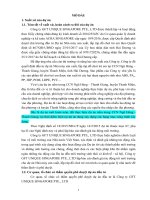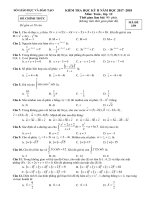Chapter 12 (spring 2017)
Bạn đang xem bản rút gọn của tài liệu. Xem và tải ngay bản đầy đủ của tài liệu tại đây (518.78 KB, 31 trang )
CHAPTER 12
SOME LESSONS FROM CAPITAL MARKET
HISTORY
Copyright © 2016 by McGrawHill Global Education LLC. All rights reserved.
KEY CONCEPTS AND SKILLS
• Know how to calculate the return on an
investment
• Understand the historical returns on various types
of investments
• Understand the historical risks on various types of
investments
• Understand the implications of market efficiency
Copyright © 2016 by McGrawHill Global Education LLC. All rights reserved.
12-2
CHAPTER OUTLINE
• Returns
• The Historical Record
• Average Returns:
The First Lesson
• The Variability of Returns:
The Second Lesson
• More about Average Returns
• Capital Market Efficiency
Copyright © 2016 by McGrawHill Global Education LLC. All rights reserved.
12-3
RISK, RETURN, AND FINANCIAL
MARKETS
• We can examine returns in the
financial markets to help us determine
the appropriate returns on nonfinancial assets
• Lessons from capital market history
There is a reward for bearing risk
The greater the potential reward, the
greater the risk
This is called the risk-return trade-of
Copyright © 2016 by McGrawHill Global Education LLC. All rights reserved.
12-4
DOLLAR RETURNS
• Total dollar return =
income from
investment
+ capital gain (loss) due to
change in price
• Example:
You bought a bond for $950 one year ago. You
have received two coupons of $30 each. You
can sell the bond for $975 today. What is your
total dollar return?
• Income = 30 + 30 = 60
• Capital gain = 975 – 950 = 25
• Total dollar return = 60 + 25 = $85
Copyright © 2016 by McGrawHill Global Education LLC. All rights reserved.
12-5
PERCENTAGE RETURNS
• It is generally more intuitive to think in terms
of percentage, rather than dollar, returns
• Dividend yield = income / beginning price
• Capital gains yield =
(ending price – beginning price)
/ beginning price
• Total percentage return =
dividend yield + capital gains yield
Copyright © 2016 by McGrawHill Global Education LLC. All rights reserved.
12-6
EXAMPLE: CALCULATING RETURNS
• You bought a stock for $35, and you
received dividends of $1.25. The
stock is now selling for $40.
What is your dollar return?
• Dollar return = 1.25 + (40 – 35) = $6.25
What is your percentage return?
• Dividend yield = 1.25 / 35 = 3.57%
• Capital gains yield = (40 – 35) / 35 = 14.29%
• Total percentage return = 3.57 + 14.29 = 17.86%
Copyright © 2016 by McGrawHill Global Education LLC. All rights reserved.
12-7
THE IMPORTANCE OF FINANCIAL
MARKETS
• Financial markets allow companies,
governments and individuals to increase
their utility
Savers have the ability to invest in financial assets
so that they can defer consumption and earn a
return to compensate them for doing so
Borrowers have better access to the capital that is
available so that they can invest in productive
assets
• Financial markets also provide us with
information about the returns that are
required for various levels of risk
Copyright © 2016 by McGrawHill Global Education LLC. All rights reserved.
12-8
FIGURE 12.4
Copyright © 2016 by McGrawHill Global Education LLC. All rights reserved.
12-9
YEAR-TO-YEAR TOTAL RETURNS
Large-Company Stock Returns
Large Companies
Long-Term Government
Bond Returns
U.S. Treasury Bill Returns
Long-Term Gove rnment Bonds
U.S. Treasury Bills
Copyright © 2016 by McGrawHill Global Education LLC. All rights reserved.
12-10
AVERAGE RETURNS
Investment
Average Return
Large Stocks
12.1%
Small Stocks
16.9%
Long-term Corporate
Bonds
6.3%
Long-term Government
Bonds
5.9%
U.S. Treasury Bills
3.5%
Inflation
3.0%
Copyright © 2016 by McGrawHill Global Education LLC. All rights reserved.
12-11
RISK PREMIUMS
• The “extra” return earned for taking on risk
• Treasury bills are considered to be risk-free
• The risk premium is the return over and above
the risk-free rate
Copyright © 2016 by McGrawHill Global Education LLC. All rights reserved.
12-12
TABLE 12.3: AVERAGE ANNUAL
RETURNS AND RISK PREMIUMS
Investment
Average Return
Risk Premium
Large Stocks
12.1%
8.6%
Small Stocks
16.9%
13.4%
Long-term Corporate
Bonds
6.3%
2.8%
Long-term Government
Bonds
5.9%
2.4%
U.S. Treasury Bills
3.5%
0.0%
Copyright © 2016 by McGrawHill Global Education LLC. All rights reserved.
12-13
FIGURE 12.9
Copyright © 2016 by McGrawHill Global Education LLC. All rights reserved.
12-14
VARIANCE AND STANDARD
DEVIATION
• Variance and standard deviation measure
the volatility of asset returns
• The greater the volatility, the greater the
uncertainty
• Historical variance = sum of squared
deviations from
the mean / (number of
observations – 1)
• Standard deviation =
the variance
square root of
Copyright © 2016 by McGrawHill Global Education LLC. All rights reserved.
12-15
EXAMPLE: VARIANCE AND
STANDARD DEVIATION
Year
Actual
Return
Average
Return
Deviation from
the Mean
Squared
Deviation
1
.15
.105
.045
.002025
2
.09
.105
-.015
.000225
3
.06
.105
-.045
.002025
4
.12
.105
.015
.000225
Totals
.42
.00
.0045
Variance = .0045 / (4-1) = .0015
Standard Deviation = .03873
Copyright © 2016 by McGrawHill Global Education LLC. All rights reserved.
12-16
WORK THE WEB EXAMPLE
• How volatile are mutual funds?
• Morningstar provides information on
mutual funds, including volatility
• Click on the web surfer to go to the
Morningstar site
Pick a fund, such as the American Funds
EuroPacific Growth Fund (AEPGX).
Enter the ticker, press go and then click
“Ratings & Risk”
Copyright © 2016 by McGrawHill Global Education LLC. All rights reserved.
12-17
FIGURE 12.10
Copyright © 2016 by McGrawHill Global Education LLC. All rights reserved.
12-18
NORMAL DISTRIBUTION
• The normal distribution is a symmetric, bellshaped frequency distribution
It is completely defined by its mean and standard
deviation
• As seen in Figure 12.10, the returns appear to be
at least roughly normally distributed
Copyright © 2016 by McGrawHill Global Education LLC. All rights reserved.
12-19
FIGURE 12.11
Copyright © 2016 by McGrawHill Global Education LLC. All rights reserved.
12-20
RECENT MARKET VOLATILITY
• 2008 was one of the worst years for stock
market investors in history
The S&P 500 plunged 37 percent
The index lost 17% in October alone
• From March ‘09 to Feb ‘11, the S&P 500
doubled in value
• Long-term Treasury bonds gained over 40
percent in 2008
They lost almost 26 percent in 2009
Copyright © 2016 by McGrawHill Global Education LLC. All rights reserved.
12-21
ARITHMETIC VS. GEOMETRIC MEAN
• Arithmetic average – return earned in an average
period over multiple periods
• Geometric average – average compound return per
period over multiple periods
• The geometric average will be less than the arithmetic
average unless all the returns are equal
• Which is better?
The arithmetic average is overly optimistic for long horizons
The geometric average is overly pessimistic for short horizons
So, the answer depends on the planning period under
consideration
• 15 – 20 years or less: use the arithmetic
• 20 – 40 years or so: split the diference between them
• 40 + years: use the geometric
Copyright © 2016 by McGrawHill Global Education LLC. All rights reserved.
12-22
EXAMPLE: COMPUTING AVERAGES
• What is the arithmetic and geometric
average for the following returns?
Year 1 5%
Year 2 -3%
Year 3
12%
Arithmetic average = (5 + (–3) + 12)/3 =
4.67%
Geometric average =
[(1+.05)*(1-.03)*(1+.12)]1/3 – 1 = .0449 =
4.49%
Copyright © 2016 by McGrawHill Global Education LLC. All rights reserved.
12-23
EFFICIENT CAPITAL MARKETS
• Stock prices are in equilibrium or are “fairly”
priced
• If this is true, then you should not be able to earn
“abnormal” or “excess” returns
• Efficient markets DO NOT imply that investors
cannot earn a positive return in the stock market
Copyright © 2016 by McGrawHill Global Education LLC. All rights reserved.
12-24
FIGURE 12.14
Copyright © 2016 by McGrawHill Global Education LLC. All rights reserved.
12-25









